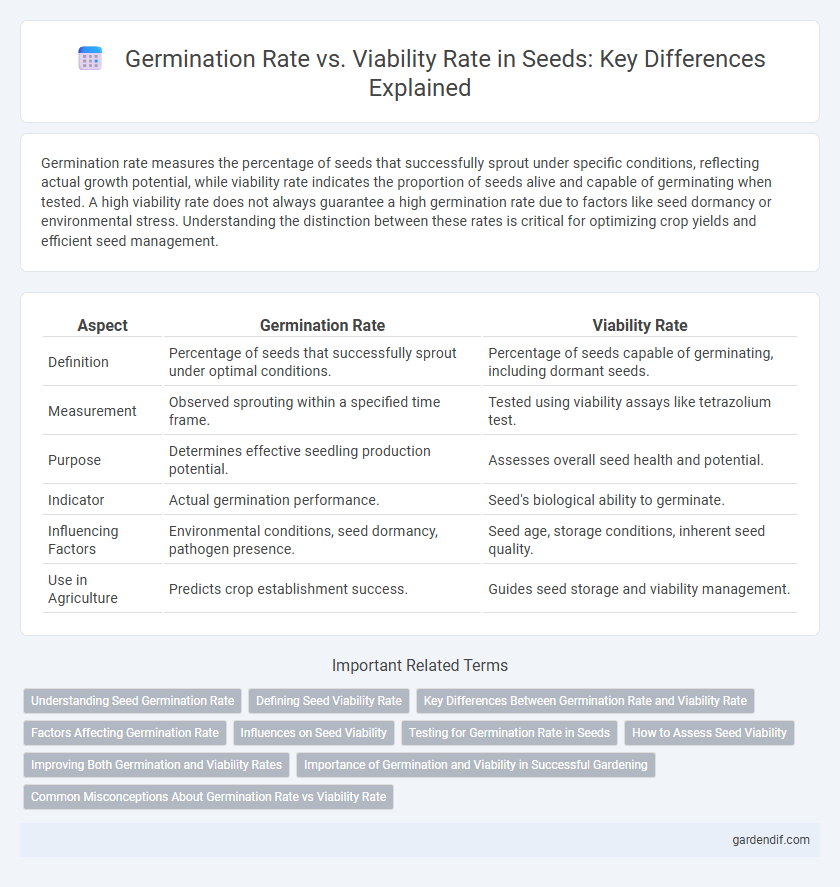
Germination rate vs Viability rate Illustration
Germination rate measures the percentage of seeds that successfully sprout under specific conditions, reflecting actual growth potential, while viability rate indicates the proportion of seeds alive and capable of germinating when tested. A high viability rate does not always guarantee a high germination rate due to factors like seed dormancy or environmental stress. Understanding the distinction between these rates is critical for optimizing crop yields and efficient seed management.
Table of Comparison
| Aspect | Germination Rate | Viability Rate |
|---|---|---|
| Definition | Percentage of seeds that successfully sprout under optimal conditions. | Percentage of seeds capable of germinating, including dormant seeds. |
| Measurement | Observed sprouting within a specified time frame. | Tested using viability assays like tetrazolium test. |
| Purpose | Determines effective seedling production potential. | Assesses overall seed health and potential. |
| Indicator | Actual germination performance. | Seed's biological ability to germinate. |
| Influencing Factors | Environmental conditions, seed dormancy, pathogen presence. | Seed age, storage conditions, inherent seed quality. |
| Use in Agriculture | Predicts crop establishment success. | Guides seed storage and viability management. |
Understanding Seed Germination Rate
Seed germination rate reflects the proportion of seeds that successfully sprout within a specific time under optimal environmental conditions, indicating the seed lot's potential for crop establishment. Viability rate measures the percentage of seeds that are alive and capable of germination, determined through tests like tetrazolium staining or cut tests, but does not guarantee actual sprouting. Understanding seed germination rate involves monitoring both germination percentage and vigor to assess seed performance and ensure effective planting outcomes.
Defining Seed Viability Rate
Seed viability rate measures the proportion of seeds capable of germinating under optimal conditions, reflecting the seed lot's potential for successful growth. Unlike germination rate, which tracks the percentage of seeds that sprout within a set timeframe, viability rate confirms the living quality and health of seeds through specific tests like tetrazolium staining. Maintaining high seed viability rates is crucial for ensuring efficient crop establishment and sustainable agricultural productivity.
Key Differences Between Germination Rate and Viability Rate
Germination rate measures the percentage of seeds that successfully sprout under specific conditions within a given time frame, reflecting seed vigor and environmental suitability. Viability rate indicates the proportion of seeds alive and capable of germination, regardless of whether they sprout immediately, often assessed through tetrazolium staining or other viability tests. The key difference lies in germination rate reflecting actual sprouting success, while viability rate represents potential germination capacity or seed health.
Factors Affecting Germination Rate
Germination rate is influenced by environmental factors such as temperature, moisture, oxygen availability, and light exposure, which directly affect seed metabolic activity during sprouting. Seed dormancy, seed coat conditions, and seed age also significantly impact germination success, differentiating it from viability rate, which solely measures the potential for a seed to grow under optimal conditions. Understanding these factors is crucial for optimizing seed treatment and storage to maximize germination rates in agricultural practices.
Influences on Seed Viability
Seed viability is influenced by factors such as storage conditions, seed age, moisture content, and temperature, all of which affect the seed's physiological integrity and ability to germinate. High humidity and elevated temperatures accelerate seed deterioration, reducing viability rates over time. Genetic traits and pre-harvest environmental stresses also play critical roles in determining the long-term viability and germination potential of seeds.
Testing for Germination Rate in Seeds
Testing for germination rate in seeds involves subjecting samples to controlled environmental conditions to measure the percentage of seeds that sprout within a specified period. This test provides accurate data on seed vigor and predicts field performance, complementing viability rate assessments that indicate the proportion of live seeds regardless of germination potential. Precise germination testing is essential for seed producers and agricultural researchers aiming to ensure high crop yields and seed quality standards.
How to Assess Seed Viability
Seed viability assessment involves conducting germination tests by placing seeds under optimal conditions and monitoring the percentage that successfully sprout within a specific period, which directly reflects their vigor. Tetrazolium staining is an alternative method, where viable seeds exhibit a red stain indicating live tissues, providing rapid results without waiting for full germination. Combining germination rate data with viability tests ensures accurate evaluation of seed quality and potential crop yield.
Improving Both Germination and Viability Rates
Enhancing germination rates and viability rates of seeds involves optimizing seed storage conditions and applying pre-sowing treatments like stratification or scarification. Proper moisture control, temperature regulation, and use of growth hormones such as gibberellic acid significantly improve seed metabolic activity, leading to higher germination success. Implementing seed priming techniques strengthens seed vigor, ensuring consistent performance and increased viability under various environmental conditions.
Importance of Germination and Viability in Successful Gardening
Germination rate measures the percentage of seeds that successfully sprout under optimal conditions, directly impacting garden yield and plant health. Viability rate indicates the proportion of seeds alive and capable of germination, essential for predicting seed batch quality and ensuring consistent crop production. Prioritizing both germination and viability rates enhances planting efficiency and maximizes the potential for robust, thriving gardens.
Common Misconceptions About Germination Rate vs Viability Rate
Germination rate refers to the percentage of seeds that successfully sprout under ideal conditions, while viability rate indicates the proportion of seeds alive and capable of germination. A common misconception is that a high viability rate guarantees a high germination rate, but factors like seed dormancy and environmental conditions heavily influence actual germination outcomes. Understanding the distinction between these rates is essential for accurate seed quality assessment and effective agricultural planning.
Germination rate vs Viability rate Infographic

 gardendif.com
gardendif.com